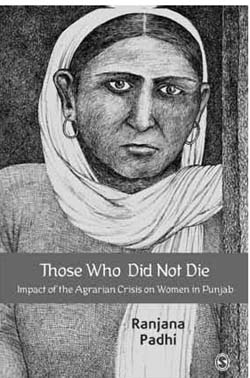One of the first thoughts after going through the book under review is the sense of deep dissatisfaction and unease with the dominant model of development as induced by World Bank and International Monetary Fund manifested in Structural Adjustment Programmes being practised in the name of development in India in general and Punjab in particular. From the feminist lens the resultant situation is more alarming as it is the women who have and are still bearing the aftershocks of such lopsided understanding and practice of development as ‘… development policy in general, and structural adjustment in particular, is not gender-neutral’ (DeshmukhRanadive, 2003: viii). Padhi’s book is an account through the voices of women survivors i.e., Jat-Sikh wives and widows and mothers how their lives are fraught with economic and familial insecurities, helplessness, humiliation in the wake of suicide committed by the male members of the family due to inability to repay back the loan to the local money lender, the arhtiya. Through the extensive fieldwork conducted intermittently during 2006–2010 of the selected villages, the author judiciously uses both questionnaire and interview tools to elicit data in narrative form which later on has been qualitatively and quantitatively analysed to arrive at ‘patterns’ of ‘structured layers of class, caste and patriarchy’ (pp. 168) affecting women. The agrarian milieu of districts of the Malwa region, Punjab provides the setting of the study. The choice of the region is much guided by the fact that it has been the seedbed of green revolution.
The book begins with the Foreword by feminist historian Uma Chakravarti who contextualizes Ranjana’s work within the need for ‘reworking’ of feminist agenda in the wake of the agrarian crisis and thereafter suicides in the overarching frame of state initiated globalization/privatization policies. The domain assumptions of the book are detailed in the introductory chapter which also serves as gateway to the ‘methodological’ issues. The first chapter gives an outline of the agrarian crisis plaguing Punjab primarily as an offshoot of the Green Revolution and the neo-liberal policies undertaken by the Indian economy in general and the state of Punjab in particular. Chapter two brings forth the nuanced understanding of women’s work and labour in resonance with feminist economists and dwells upon the changed nature of work women have to undertake in order to survive after the suicide of the male farmer. Chapter three unravels the customary practice of dowry mandatory at the time of marriage of daughter and its further damaging effect on the whatsoever meager assets a small and marginal farmer owns. The impending health issues of the women as well as the family members and their economic inability to address their health needs forms the core of chapter four. Chapter five discusses how the familial relations get strained under the pressure of surmounting debts and inability (either intentional or unintentional) of the parties involved to repay the same, and the sense of alienation experienced by the elderly family members, in this case the women particularly. In a way, chapter six speaks of the spaces (howsoever small and distant) of hope and intense desire to live life in a better way than the present.

